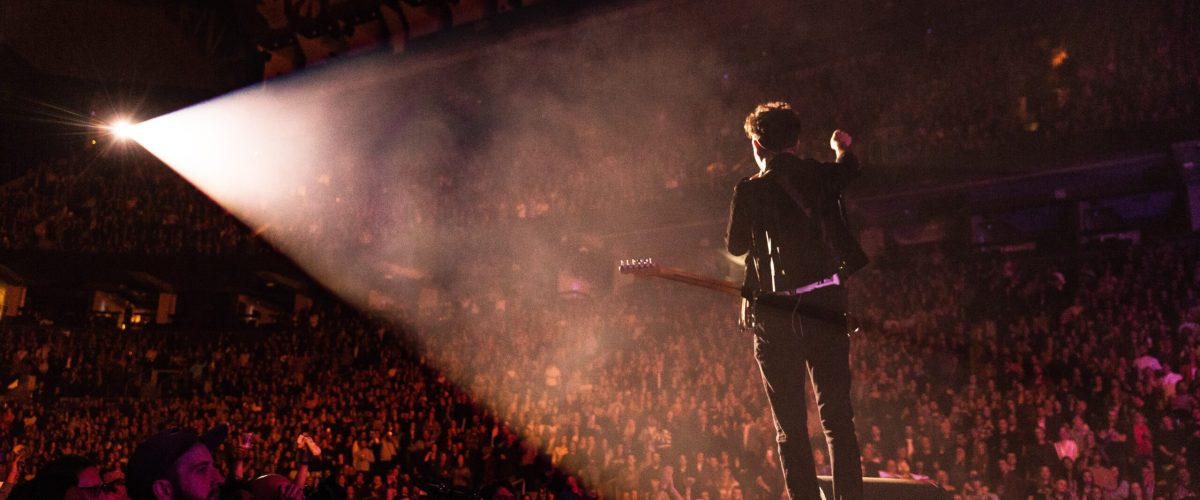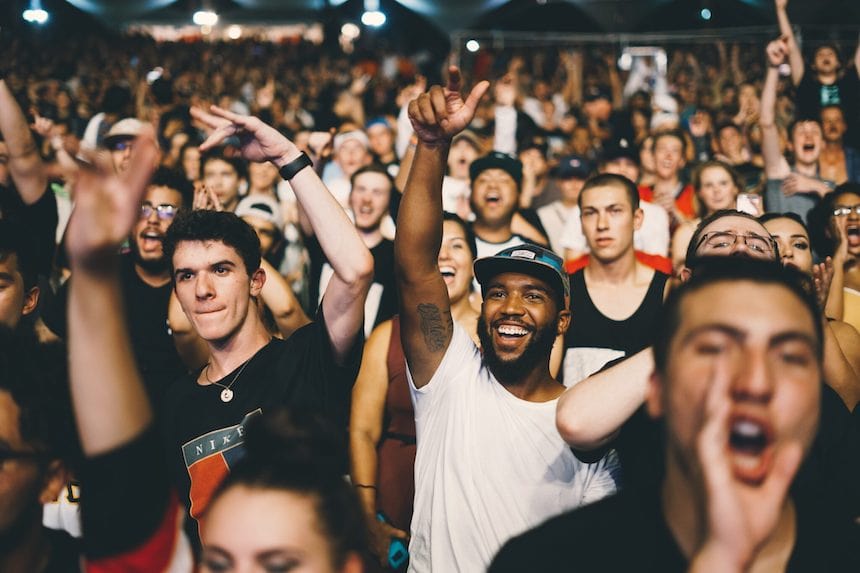We’ve all heard about the recent incidents of concert behavior such as objects and water being thrown, fans jumping on stage, grabbing microphones, etc. as major artists are performing. These incidents make the news because the artists are famous and newsworthy. Many such incidents occur routinely at less renown concerts and venues. What the publicity has done is highlight the need for protecting performers better as they entertain fans.
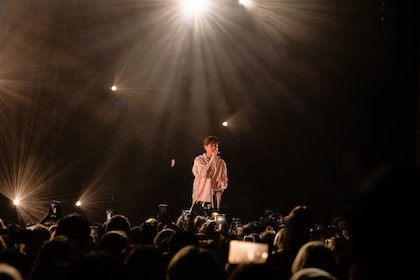 Along with these physical altercations, there are many other potential hazards performing artists can face as they prepare and carry out their performances. Musicians and concert performers are potentially vulnerable and exposed to a number of safety issues from trips and falls, stage perils, physical confrontations, flying objects and other hazards.
Along with these physical altercations, there are many other potential hazards performing artists can face as they prepare and carry out their performances. Musicians and concert performers are potentially vulnerable and exposed to a number of safety issues from trips and falls, stage perils, physical confrontations, flying objects and other hazards.
Most recent concert safety initiatives address the safety of concert goers. While it’s exceedingly important to keep concert guests safe during a concert, it’s also important to safeguard the musicians, singers, dancers, and concert crew involved in putting on a concert.
This article will address artist safety concerns and the obligations of venues and promoters for protecting performers.
Venue and Promoter Liability for Protecting Performers:

I think we all agree that a venue owner or operator which controls access to that venue has the duty to maintain the premises in a reasonably safe condition fitting to the events conducted there. This duty is subject to the test of reasonable foreseeability. In other words, the venue is not required to protect those there from every conceivable risk but is required for those that are reasonably foreseeable. This is true for both protecting performers as well as those that come to see their performance.
In tort negligence lawsuits, foreseeability asks whether a party could or should reasonably have foreseen the harms that resulted from their actions. If resulting harms were not foreseeable, a defendant might successfully prove that they were not liable (source). Legal case law holds that the mere act of providing security for a potential incident establishes liability for breach of duty even without a prior incident at a particular venue. Put another way: The fact that a party in control of certain premises undertook certain precautionary measures may be evidence that an owner defendant had actual or constructive knowledge of a dangerous condition.
Promoter Liability:
Promoter liability is judged differently than venue liability. Major promoters have contracts with concert venues to give them the ability to decide what security measures are required by the owners of the venues for their events. This arrangement puts promoters in the same shoes legally as the venue operator for liability issues since their contract puts them in control of access and security for their events.
This creates a duty to use reasonable care when it comes to protecting performers as well as attendees from foreseeable harm. One top of this is the fact that artists contract directly with promoters for events in which the promoter is responsible. Such contracts almost always provide that the promoter is responsible for the artists’ security. Should an incident resulting in liability occur at a venue, the promoter could be held responsible, and the artist would have a direct breach of contract action against the promoter.
In these situations, the contract privity exists with the promoter and not the venue. It’s the concert promoter who benefits from the artists’ performances. It’s the promoter’s duty to provide a safe environment for the artists before, during and after their performances. This is a standard practice of the industry for a tour sponsored by a promoter. That doesn’t preclude the promoter’s contract with the venue for a reasonably safe working site also entering into any determination of liability for incidents resulting in injury to those involved with a concert.
Depending on the particular circumstances, a promoter, venue owner, or both may be liable for injuries or damage for incidents that could occur during the preparation for, carrying out, and post-concert activities. Venues and promoters need to take reasonable steps to protect both the audience AND those involved in the performance themselves.
Protecting Performers: Some Safety Concerns
- Fan Behavior Putting Artists in Jeopardy: Music industry experts are saying that bad fan behavior has become the new norm (source). Entertainers have been hit by thrown items, accosted by fans on stage, and experienced other unruly fan behaviors that have impacted their ability to perform for their fans.
While some behaviors are not new and even encouraged by certain music genres and entertainers in the past, today’s fans are taking them to new and dangerous heights. There’s a big difference between throwing women’s underwear on stage for an Elvis concert and throwing phones and their mother’s ashes at an artist while performing. This dangerous behavior has resulted in injuries to major entertainers.
While several performers are now speaking out at their concerts to remind fans of the need to be respectful and cease dangerous behaviors, there are things that venues and promoters can do to better protect performers from such behaviors. Some are distasteful to artists who don’t want to increase the physical and passionate distance from their fans. Others are efforts to remind fans of the rules for concert etiquette. Here are a few steps promoters and venue can take.
-
- Pre-Show Announcements: Take every opportunity to remind those buying tickets what is expected of them in terms of concert etiquette. Examples include ticket confirmations, social media posts, box office announcements, venue posters and emcee announcements. Inform concert goers what is expected of them and the consequences of bad behavior. Such announcements can set the tone for the concert and discourage inappropriate behaviors.
- Increase Near Stage Security: Increase the overall security at the concert particularly near the stage to deter disruptive behavior. Having security staff near the stage allows them to keep a close eye on fans and take steps to prevent or intervene if incidents occur.
- Create a “safe” zone by setting up barricades between the stage and the audience. Doing so increases the distance between the artist and the audience and can reduce the chances of thrown objects reaching the entertainers. Such a safe space also allows that space to be occupied by security to keep a better eye on those near the front of the venue.
- Increase lighting: Providing enough lighting near the stage so that security can see potential attendees who are exhibiting bad behaviors and allowing security the opportunity to discourage them from doing so.
- Video Surveillance: Venues can use video surveillance to discourage incidents by notifying fans of the surveillance so they know that individuals engaging in bad behavior can be identified. Monitored cameras can also spot issues that can be addressed by security before it impacts the artists performing.
- Artists’ Announcements: The artists themselves can take matters into their own hands and stop their show to remind fans on what is expected of them during their performances. Hopefully, if the other steps listed above are taken, they should not have to do that.
- Protecting Performers from Common Stage Safety Issues
In the U.S, OSHA does not have industry specific standards for the entertainment industry. Generally, the entertainment industry would be covered under the general industry standards for the specific issue, e.g., working at heights.
-
- Material Handling Safety:
The most common injuries associated with concerts are those involving the moving or lifting of the objects that are a part of load in and preparation for the concert. Often less renown artists will assist with load in and load out. They and their crew may not be well versed in material handling techniques regarding lifting and carrying techniques to prevent injuries. There are many sources for information on this topic. Here’s a good one from OSHA.
-
- Falling and Slipping Issues:
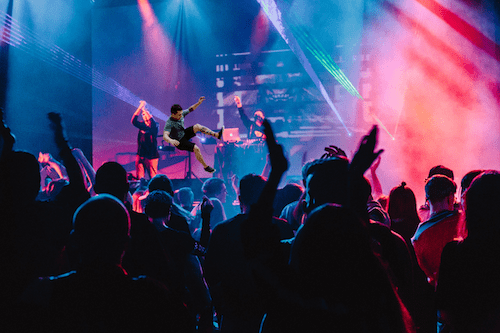
-
-
- The stage floor and ramps leading to it should be inspected prior to load in and the performance. The stage floor should be clean and smooth with no trip hazards. A reputable manufacturer or structural engineer should design all staging. Stages should be well maintained, repairing any issues with wear that may occur. The surface of any ramp or tread, particularly those that could become wet, should be covered with slip-resistant material.
-
-
-
- Raked stages result in more injuries to dancers (source) or other performers. They are still found in many theaters. Level stages should be used if possible.
- Tripping over cords can be minimized by using the fewest number of cables lying across the floor, placing them in areas with the least amount of traffic and taping them to the floor using gaffer tape. Avoid using extension cords.
- Make sure that the entire stage is well lit to avoid accidents.
- Make sure that the front of the stage is well marked and can be seen by artists to avoid them falling off the stage.
- Special Effects.
-
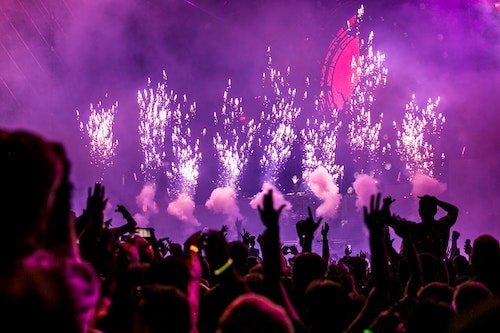
The use of special effects increases the risk of personal injury and property damage. Since most are stage effects, they represent a significant safety hazard to stage performers and crew as well as those attending the performance. Major tours bring all their production equipment with them. The major reason is that the crew for the production elements are highly qualified and well-rehearsed so that the show goes off smoothly and the equipment, props, special effects, etc. are of the highest quality and inspected before and after every show. It’s not only about a great show, but also about a safe show by eliminating the need and the risks that come with relying on others to provide what is needed for the show.
Let’s look at the risks and safety measures needed for special effects used more commonly. It’s important to post warnings about the use of special effects that could pose a problem to certain members of the audience when used in indoor spaces. Good practice includes describing the special effects on box office event descriptions as well as at the entrances to the event.
-
- Smoke, Fog, and Haze: Carbon dioxide (CO2) fog machines and glycerin smoke machines are used to create fog or smoke on stage. CO2 fog machines work by releasing carbon dioxide into the air. As it expands it condenses water vapor in the air and creates the fog effect. Because it’s heavier than air, it pools on the stage or flows like water, creating a walking on clouds or bubbling cauldron of liquid. That advantage is also a safety issue in that the CO2 will pool in low areas like under the stage and will displace oxygen in enclosed areas creating a health hazard.
When used properly, CO2 effects are safe. However, you should be cognizant of the potential for human error especially when used in enclosed spaces. Make sure all event spaces are well ventilated, use trained people, aim away from people, and use a CO2 monitor in less-than-ideal circumstances.
The use of smoke machines and their health risks are still being debated. They work by heating up and vaporizing a fluid, creating a mist or fog, not actual smoke. That fluid consists of distilled water and a little propylene glycol and a coloring agent. Prior to 2015 they used diethylene glycol which regulations now prohibit because of the potential for respiratory damage with long-term exposure.
The quality of the smoke machine and the liquid used is important as lower quality machines and liquids result in the liquid burning rather than vaporizing. The latter may result in a harmful mist. Performers who use them over and over in their concerts may increase the risks involved with long term exposure. Use common sense and only use smoke machines in well ventilated spaces.
The use of machines that generate water droplets on stage also creates both electrical risks as well as the potential to create slipping hazards. Placing condensate collection pans under such special effects machines can reduce stage moisture issues.
-
- Laser and Strobe Lights: When laser and/or strobe lights are used in a production, people should be warned about their use. That’s because the use of such lights can induce seizures in certain people with photosensitivity or epilepsy. The use of such lighting can also distract or impair a performer’s vision, increasing the risks to them as they perform on stage.
- Pyrotechnics: Pyrotechnics are used to create an elaborate spectacle for concerts. Whether it’s sparks raining down or pillars, fire erupting from the stage, confetti, or even sound booms, many entertainers use pyrotechnics to make their concerts more elaborate than they otherwise would be. Their use indoors creates the need for safety to be the top priority. Major incidents have even occurred with big-name touring bands resulting in deaths and injuries.
Their use is a highly specialized field that requires extensive knowledge of chemistry, physics, and engineering. They should adhere to local codes for such use and only used by a reputable pyrotechnics company and well-trained pyrotechnics technicians. Other safety measures should include:
-
-
- Following industry standards and local codes in their use.
- Using flame-proofed materials when possible and Keeping them away from flammable materials.
- Making sure they are never pointed toward people.
- Designating fire watch attendants and having fire extinguishers and fire blankets ready to use in case an incident occurs.
- Warning those planning to attend about the use of pyrotechnics and other special effects.
- Providing safety data sheets for any materials used and making sure venue staff and emergency services agencies have access to them.
-
Because of their potential for danger, they should only be used in larger venues with big-budget productions.
This article only addresses some of the most common safety concerns for artists as they prepare and perform during live events. While there are many more potential hazards, these are the most common and should be top-of-mind for both venues and promoters. The risks involved are easily foreseeable and venues or promoters have a duty to use reasonable care to protect those performing as well as attendees from such foreseeable harms.
Related Posts:
